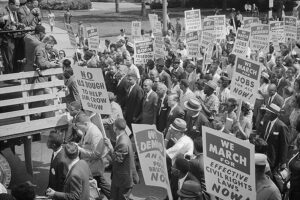![FS_07P_082113 Library of Congress Prints and Photographs Division [LC-DIG-ppmsca-04297]](https://mhebtw.mheducation.com/wp-content/uploads/2013/08/FS_07P_082113-678x381.jpg)
One of the organizers of the March on Washington for Jobs and Freedom was Bayard Rustin. Rustin was an activist for many social causes in the United States during the 1950s and 1960s. He worked with A. Philip Randolph and the other main leaders of the March to ensure the event was completed safely and smoothly.
People from all over the nation came to Washington in August 1963 to voice their hope for freedom and equality. Much of the organization that occurred prior to August 28 was to anticipate the needs of the hundreds of thousands of people converging on the nation’s capital city. Knowing the protest would be televised, the thousands of the official March’s signs were distributed through the crowds by volunteer marshals.
Given the crowds of people that made up the March on Washington, it is remarkable that events did not get out of hand. Local Washington, D.C. police played an important role in keeping everyone organized. Still, the civil rights movement years featured many large protests that did turn violent. It is a testament to the efforts of the March organizers and the overall goal of nonviolent protest that ensured that this historic event was not remembered for injuries and angry crowds.
The signature event of the March on August 28, 1963 was Martin Luther King, Jr.’s speech on the steps of the Lincoln Memorial. Those who stood behind Dr. King during his speech saw a view of Washington D.C. much like this one. The statue of Lincoln, the Great Emancipator, was behind them while the memorial to the nation’s first president was in the distance before them. Between stood the citizens of the nation, responsible for guiding the democracy to its best ideals.




